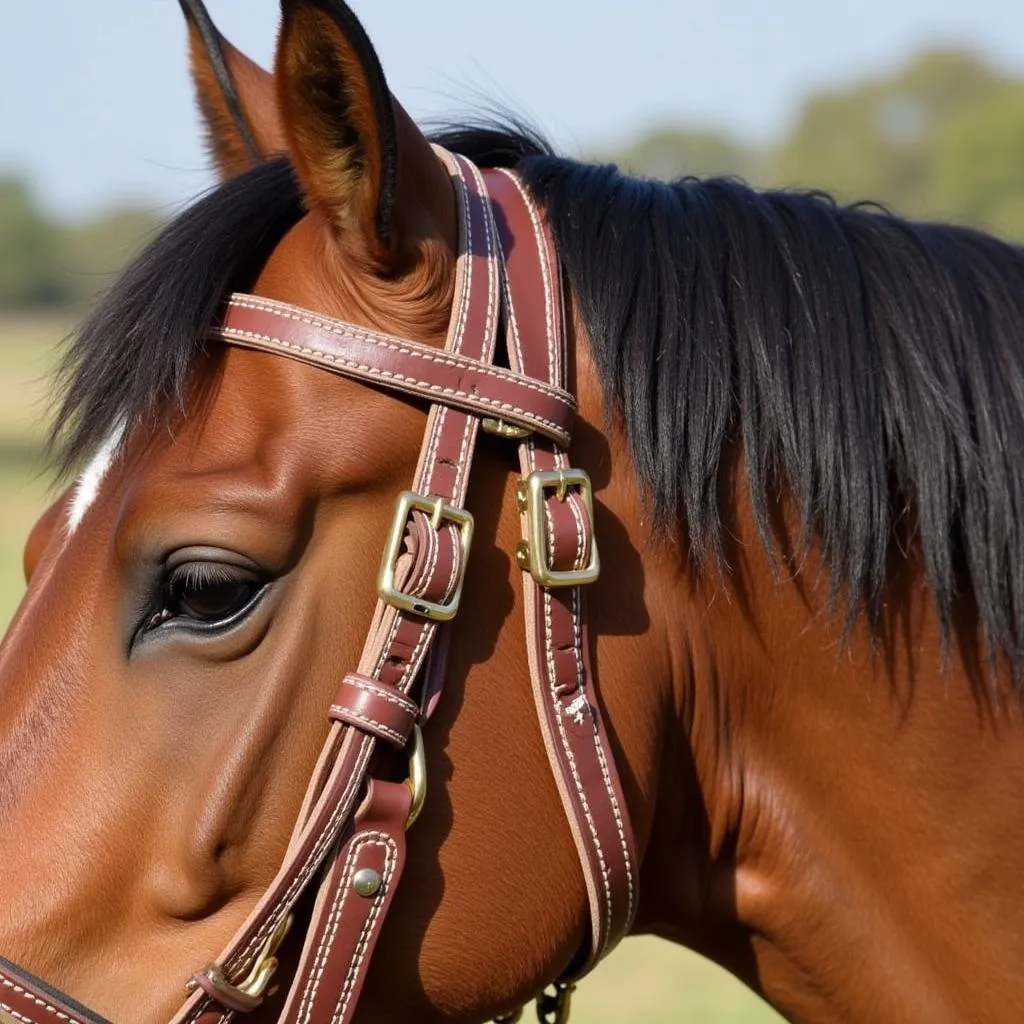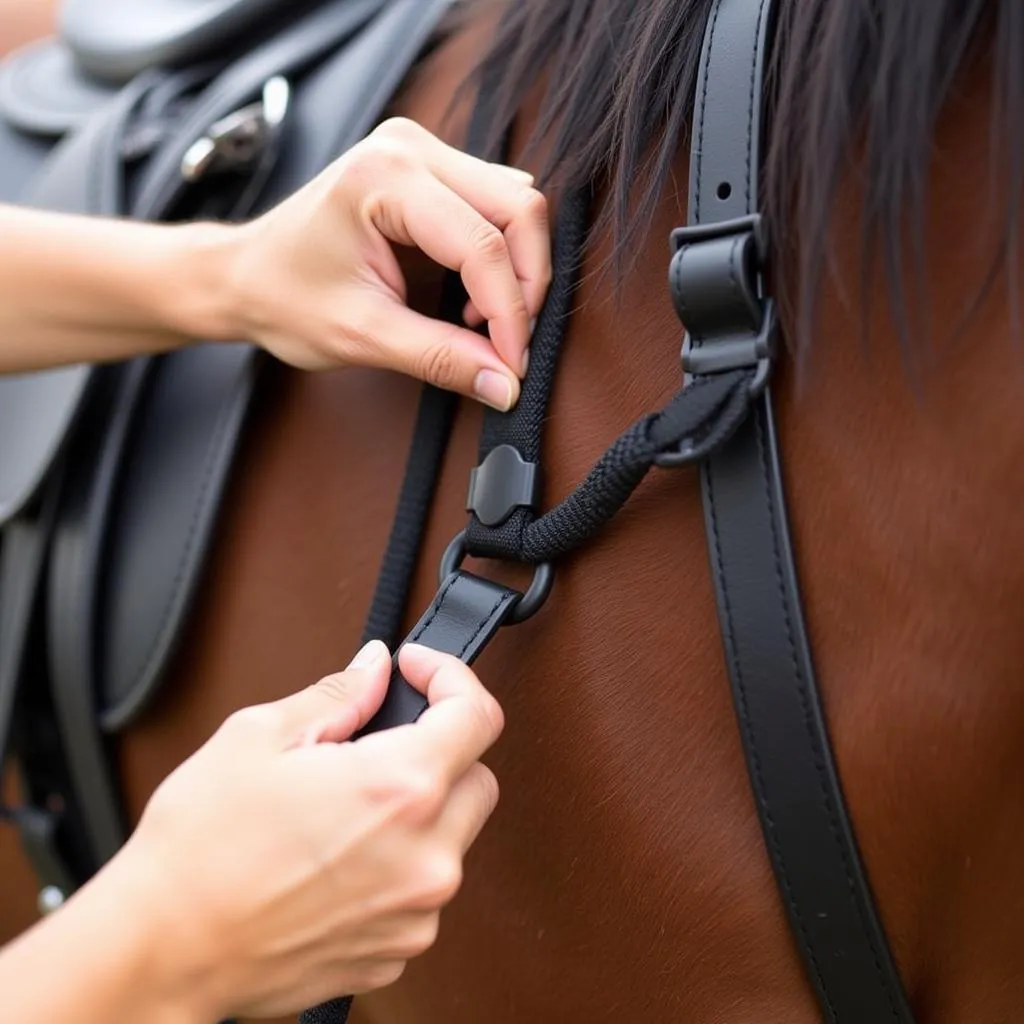A wither strap, also known as a breastplate or breast collar, is an essential piece of tack for many riders. It helps to keep your saddle secure and prevents it from slipping back, especially during activities like jumping, trail riding, or riding a horse with a forward girth groove. But with so many different types of wither straps available, choosing the right one for your horse can feel overwhelming.
 Leather wither strap with running attachment
Leather wither strap with running attachment
Understanding the Purpose of a Wither Strap
Before we delve into the specifics of choosing and fitting a wither strap, it’s crucial to understand why they are used. The primary function is to provide an additional point of attachment for the saddle, preventing it from sliding backward. This is particularly important for horses with certain conformations:
- Horses with a forward girth groove: These horses naturally have a girth groove positioned further forward, making the saddle more prone to slipping back.
- Horses with a high wither and short back: This conformation can also lead to saddle slippage, especially during activities that put extra pressure on the back of the saddle.
- Horses participating in disciplines requiring quick stops and turns: Disciplines like barrel racing, jumping, and polo involve sharp movements that can shift the saddle.
 Horse wearing a wither strap while jumping over an obstacle
Horse wearing a wither strap while jumping over an obstacle
Types of Wither Straps
Wither straps come in various designs, each offering unique features and benefits:
- Hunting Breastplate: This traditional style features a Y-shaped strap that attaches to the D-rings of the saddle and runs between the horse’s front legs to connect to the girth.
- 5-Point Breastplate: Offering maximum stability, the 5-point breastplate includes an additional strap that loops around the girth and attaches to the center chest strap.
- Breast Collar: Unlike breastplates that attach to the girth, breast collars fasten directly to the saddle’s girth straps, providing more freedom of movement.
- Running Breastplate: This type is designed to prevent the saddle from slipping back while allowing for a full range of motion in the horse’s shoulders.
Choosing the Right Wither Strap for Your Horse
Selecting the appropriate wither strap depends on several factors:
- Horse’s Conformation: Consider your horse’s build and any conformational traits that might necessitate a specific type of strap.
- Riding Discipline: The type of riding you do will influence the level of stability and freedom of movement required.
- Material and Fit: Wither straps are typically made from leather or synthetic materials. Ensure a proper fit to avoid discomfort or rubbing.
Fitting a Wither Strap Correctly
A poorly fitted wither strap can cause discomfort and even injury to your horse. Here’s how to ensure a proper fit:
- Position the wither strap: The wither strap should sit comfortably behind the horse’s shoulder blades, not restricting their movement.
- Adjust the straps: The straps should be snug but not overly tight. You should be able to fit two fingers comfortably between the strap and the horse.
- Check for clearance: Ensure there is adequate clearance between the strap and the horse’s elbows and chest to prevent rubbing.
 Close-up of a hand adjusting a wither strap on a horse
Close-up of a hand adjusting a wither strap on a horse
Common Wither Strap Issues and Solutions
Even with a well-fitted wither strap, you might encounter issues. Here are some common problems and solutions:
- Rubbing: If the wither strap rubs your horse, consider using a sheepskin wither strap cover or padding the strap with fleece.
- Slipping: If the wither strap slips, ensure it is fitted correctly and the straps are adjusted properly. You might need a different style of wither strap.
- Discomfort: Some horses might initially find a wither strap unusual. Introduce it gradually during groundwork and short rides.
FAQs
Q: Can I use a wither strap on any horse?
A: While not all horses require a wither strap, it can be beneficial for many, especially those prone to saddle slippage.
Q: How do I clean a leather wither strap?
A: Clean your leather wither strap regularly with saddle soap and condition it with leather conditioner to maintain its quality.
Q: Can a wither strap be used with a martingale?
A: Yes, wither straps and martingales can be used together, but consult with an experienced trainer to ensure proper adjustment and compatibility.
For further assistance choosing the right wither strap for your horse, contact us at Phone Number: 0772127271, Email: [email protected] Or visit us at: QGM2+WX2, Vị Trung, Vị Thuỷ, Hậu Giang, Việt Nam. We have a 24/7 customer support team.